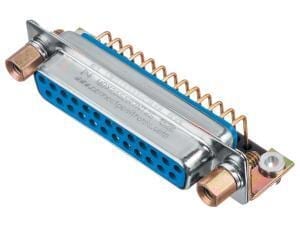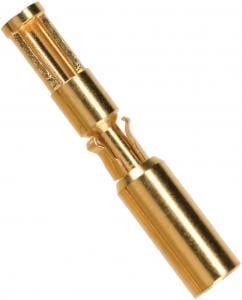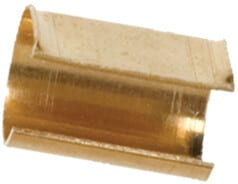PosiBlog
PosiBand: A Positive Grip on Electronic Connectors
by Mark Martin, Sr. Engineer at Positronic
When life throws us for a loop, our friends and family may pull us aside and say: “Get a grip!” Important advice and, of course, a great challenge when times are harsh and tumultuous.

There is a parallel in the world of high-reliability electrical connectors. There is nothing more fundamental to the business of electrical efficiency than establishing and maintaining strong, solid connections—getting a grip. That is simple to say and so very complicated in application, especially when the environments for which we are building connectors and other components are harsh and unpredictable. It is what keeps those of us in engineering, and our customers who design the equipment that include our components, always looking for more effective and efficient ways to maintain a safe and solid current!
That brings us to one of the innovations that Positronic is quite proud of. It is called PosiBand, and to state it simply, it does a better job of putting a positive grip on connections than anything else in its class, assuring that there is constant power provided through our connectors, such as D-subminiatures, even in the most rugged environments.
Closed entry female contacts are often used to enhance the performance and reliability of connectors. PosiBand is a closed entry connector that includes a spring-loaded sleeve. The best way to understand Posiband and its strengths is to compare it to the common closed entry design called a split tube or split tine.
Split Tine Connectors
With split tine connectors, the main part of the contact is a split tube with points to provide normal force on male contacts when connectors are mated. In many cases, a sleeve is placed over a standard split tine contact to achieve the closed entry feature. The closed entry feature is crucial in preventing damage to female contacts used in harsh environments, repeated mating cycles, blind mate applications and applications requiring highest reliability. If female contact tines are forced to open too far, they may not return to their original position. This may cause diminished normal forces and can result in intermittent or open electrical circuits.
Other weaknesses of split tine contacts revolve around the fact that the tines must be depressed to provide normal force. Also, since the tines slope toward a point, there is a reduced area of contact between the male and female contact interface.
Split tine contacts are manufactured using a material with elastic properties to allow for contact insertion. The crimp barrel is then annealed to soften the material so a proper crimp can be achieved. If the annealing process is not carefully controlled, the mating portion of the contact may unintentionally be annealed. This will result in diminished normal forces and potential electrical failures.


The PosiBand Advantage
Positronic’s PosiBand technology takes a unique approach, eliminating many of the weaknesses of the split tine design.
- PosiBand contacts use a two-piece contact design. Each piece serves a separate function. The main body of the contact provides the mechanical platform for the contact system. This includes a true closed entry contact opening. The PosiBand spring clip provides normal force on the male contact.
- The PosiBand system does not have a split tine female contact that can be pried open during the mating process. Instead, it uses the PosiBand spring clip, which is robust and less susceptible to damage.
- Another important feature of the PosiBand system is the use of brass to manufacture the base contact. Brass has excellent properties for crimping wire onto contacts, eliminating the need for annealing. The base contact can be made of brass because the PosiBand spring clip provides contact normal force. The spring clip is made of spring tempered beryllium copper.
- PosiBand has greater surface area at the male and female contact interface, resulting in more consistent electrical performance compared to the sloped design of split tine contacts. The greater contact area provides more reliable electrical integrity.
- This larger surface area produces lower contact resistance, resulting in less heat build-up. Low contact resistance offers opportunities to use size 22 and size 20 contacts for power. (Resistance of size 22 contacts is 0.005 ohms, maximum. Resistance of size 20 contacts is 0.004 ohms, maximum).
- Greater contact area provided by the PosiBand system does not increase insertion forces. In fact, the PosiBand design provides a more consistent insertion force value, which results in a lower average insertion force, compared to the split tine design.
- Specific PosiBand technology has been used by Positronic for many years and is now being imported into a variety of products. We qualify our product to mil-area specs, used where high reliability is needed. PosiBand is qualified under SAE AS39029 and MIL-DTL-24308 specifications. PosiBand is also qualified under GSFC S-311-P4/08 and GSFC S-311-P4/10 to the higher 40 gram contact separation test requirement. PosiBand is protected by US Patent 7,115,002. Posiband is used in D-sub miniature product lines for military and space applications. Positronic is the only manufacturer using Posiband; others that are producing machined-contact connectors use the split tine design.
When it comes to promising the science of certainty in connections, there is no parallel to Positronic’s PosiBand system, the most reliable way to get a positive grip on the challenge of electrical connection.
Latest Posts
- Milexia and Neumueller Named as Exclusive Value-Add Distributor Partners for UVAC Hermetic Feedthrough Flange System March 26, 2025
- Powering the Future of eVTOL Aircraft Travel January 24, 2025
- MACH-D Connectors: Highly Reliable & Customizable August 29, 2024
- Combo-D Connectors from Positronic: Compact Power and Precision May 1, 2024
- A Series Backshell Product Derivative: Introducing Precision Machined Banded Backshells March 12, 2024